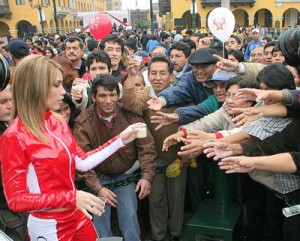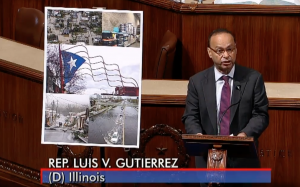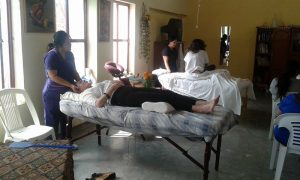By M. Isabel Guerra
LatinaLista
LIMA, PERU — An incident that took place at a Lima shopping mall last weekend brought the attention back to the issue of racism in Peru. An indigenous from Cusco, who was visiting Lima on the invitation of some American friends, was treated with disrespect by the entrance guards of a movie theater, and finally was not allowed to re-enter after going to the restroom.

This was reported by some Twitter users and jumped quickly into the local news, generating many different reactions in both social media and the press — even the local government decided to start an investigation on this, in order to clarify the real facts.
(Update: At the time of publication of this post, the Municipality of Miraflores announced that the movie theater would be shut down for a week due to the discrimination charges.)
But this was only the latest story, an isolated incident that is now being used to promote some social media campaigns to raise awareness of the issue. And raising awareness is necessary because the shameful truth is that racism in Peru is still very alive.
We saw it booming and reaching surrealistic levels during the last presidential campaign, and especially after the first run, when it became clear that Pedro Pablo Kuczinsky, the “white” candidate, had not made it to the run-off. Social media, especially Facebook, was the platform for a “death-to-all-those-indians” (presumaby, they had voted for “that indian Humala”) hatred campaign, that was quickly denounced throughout other pages on Facebook, like that of Vergüenza Democrática which collected many of the most offensive posts.
¿”Whites”? ¿”Indians”? ¿Isn’t Peru a mestizo country?
A popular Peruvian saying states: “En el Perú , quien no tiene de inga, tiene de mandinga” “In Peru, whoever doesn’t have inga [Indian heritage] has mandinga [black heritage].” Well, yes — biologically speaking. We are a pluricultural country; we have a complex racial background (Spanish, Indian, African) enhanced with immigrants from Asia and Europe who have made the population ethnically richer and even more complex.
Many Peruvians will tell you that racism does not exist in Peru — this is partly the reason why it still survives. The victims refuse to believe they have been mistreated due to racism, and racist people have been subtly educated to assume racial discrimination is like something “normal,” so they don’t even notice. In any case, denial helps everyone to avoid assuming this painful and complex social situation.
I tend to agree with this description provided by the blog My Life in Peru: “…it’s not the kind of racism I’ve seen in the US, where you see an actual hatred for those of another race. Here [in Peru], it’s more of a caste type system where it’s typically assumed by people in Peru that you have – or are deserving of – a higher status in society if you have paler skin. In general, lighter skinned people (whether actual gringos or light-skinned Peruvians) are treated with more respect. And in the end, what’s the difference between that and any other type of racism?”
These issues started centuries ago, especially during the Spanish Vice Royalty, when the dominant, Spanish/Creole elites needed to clearly state its position of privilege. Centuries passed, Peru became an independent country, but the feudal mentality somehow remains.
If we review some of the Peruvian history, we’ll see that the political power in Peru has been mostly in “white” hands, excluding natives and other non-white nations. But what does “white” mean in Peru?
Basically it means non-indian, non-native, non-African… non-colored. But the real meaning of “white” (or “pituco” in slang) in Peru is much more related to economic power and to social status rather than to DNA. It means belonging to the elite social group that can have privileges based solely on its appearance, social relations… and on its wallet.
¿Classism or racism? ¿Both?
As Lima’s BBC correspondent, Dan Collyns explains: “The country has socio-economic gaps along race lines and its inherent, if subtle, discrimination can mean an indigenous woman may only ever work as a maid; a black man may only ever aspire to be a hotel doorman. This is the kind of everyday racism which dictates the lives of many Peruvians.”
Nowadays, racial discrimination in Peru can be seen in many places, despite the existence of anti-discrimination laws.
As an example, a non-white black person may be not admitted into a discotheque in a fashionable neighborhood, unless he or she is accompanied by a wealthy white person, or by a foreigner tourist. The official explanation will be, however, “we are already packed”, “we’re hosting a private event” or “admittance is only for members”.
Many job ads list “buena presencia” (“neat appearance”) as one of the requirements. Families will explicitly ask funeral houses to provide black pallbearers. Most local TV hosts, soap opera stars, news anchors, and models for department store catalogues are “whites”, or at least white-like looking.
Certain beach clubs and condos have enclosed their properties with fences. People hire maids and force them to wear uniforms in public spaces. Media does not hesitate in bullying lawmakers from indigenous or African descent. Andean and Amazonian communities’ rights are ignored under the pressure of corporations’ lobbying. Taking a look at the Peruvian Navy, you will not find any colored high-rank official. And the list goes on and on and on…
And Peruvians have learned to live pretending that nothing of this is happening, trying to joke about it, or simply believing that this is just the way things are and there is nothing that can be done about it. However, there are human rights activists raising awareness on this matter.
Wilfredo Ardito, from Aprodeh explains: People are skeptical at first, or they think we are going to talk about Martin Luther King and the civil rights movement…then they realize it is about their experience and then they share with others experiences of racism …”
Even the Peruvian Ombudsman is working on a strategy to fight racial discrimination. According to one of their documents, they are aiming “(1) to strengthen legal protection against discrimination through lobbying for legal modifications; and to (2) generating public awareness and support through high-profile media campaigns.”
Things are slowly changing.
Many people still remember that in 2007 an upperscale restaurant, Cafe Del Mar, was shown on TV discriminating against a mestizo couple. A hidden-camera video showed these images, as well as, the fact that they were told that they needed an invitation. However, after the couple was told this, a white customer was allowed in without being asked to show his invitation. Due to this, and to other similar allegations, the place was denounced and finally was closed for two months and fined US $70,000.
But many more effective measures are necessary, especially state-approved policies (laws, initiatives, educational campaigns, etc.) since racism is not an issue that will disappear on its own.
There are many pending tasks and challenges to this issue, and let’s see if the new government dedicates attention to this matter — if it really wants to make Peruvian society a truly inclusive one.
Learn more about Isabel
With a Master’s degree in Communications from the University of Lima’s School of Communication Sciences, Isabel specializes in covering stories regarding art and culture.
She also has an interest in photography, especially the area of photo journalism. She is a contributing photographer for Getty Images Latin America. Her photos can also be found in her Picasa Photo Album and in her fotoblog Bubblepics.
As if her photography doesn’t keep her busy enough, Isabel maintains the blog Las Burbujas Recargadas while also lecturing at the San Martin de Porres University’s School of Communication and serving as an author for Global Voices Online.





Comment(10)
Marisa
It is extremely sad. Isabel, our Latina Lista contributor who wrote this piece, asked me if I was surprised to read that this level of discrimination exists in Peru and I could honestly say no. Not because I’ve heard or read stories like the one you’re describing but because when I watch the telenovelas aired in the US from South America, unbelievably, they still think it’s ok to portray people like that. Maybe we should have an international effort to stamp out this kind of racial discrimination.
Bernardus Holtrop
Very interesting story Isabel! I didn’t know about this part of the Peruvian culture.
In the Netherlands, where I live, racism does exist also, but in the way of dna and lifestyle (for example Muslim looking, not fluent in Dutch etc.) only. Our culture has changed a lot in the last decade. We used to be very “decent” people after WWII, but now populism (right wing, pity) is getting more power and that means that society grows harder and less tolerant, less caring. The Netherlands is very much a multicultural country.
Nowadays its not done to speak bad of black people or Muslims etc. openly, but a lot of people still dislike them in their thoughts. The last 2 or 3 years we see that gays are more often beated up. That’s a remarkable occurrence since it went so well all these decades. Like we’re going back in time.
richard
This is not an issue unique to Peru by any means. Where I live, Colombia, it’s just the same. The term employed frequently to belittle those of indigenous descent and their customs is the “malicia indigena”. This is employed in common vernacular to provide an excuse for behaviour or a lifestyle that remains misunderstood by the country’s white European elite.
Nick
This socialization of exclusivity and class has solid roots in the education system. Peru’s schools of all classes and price levels has a practice of evaluation with a “school psychiatrist” as if one 5 year old over another 5 year old has put in the necessary studies to enter a particular institution more than another. The schools (international and Peruvian) selectively choose students and families based on connections, skin tone and native language and thus families claim their children’s school as a reflection of their standing in society. For someone with a child entering into school in Peru it’s been a very surreal experience observing such overt discrimination. This is considering my child is white, speaks native English and whose parents have the ability to pay for one of the better institution in Peru. It’s sad that these institutions will only re-enforce racial and social segregation. Peru has so much potential and beauty and it’s a country I call home. Although until the day the powerful and wealthy of this country understand that their privilege will not be threatened if the maid’s and doorman’s progress in society improves, we will continue to be doomed with the burden of racism.
Isabel Guerra
Thank you very much for your sooooo valuable comments… yes, this seems to be surreal sometimes, but no, it’s REAL.
Peru: Racism Debated on Social Networks · Global Voices
[…] many unfinished tasks and challenges to make Peruvian society truly inclusive. Adapted from “Peru: Racism, still a pending issue“, originally published by Latina Lista. Written by Isabel Guerra Posted 21 December […]
Peru: Rassismusdebatte in sozialen Netzwerken · Global Voices auf Deutsch
[…] stellen, um die peruanische Gesellschaft wirklich inklusiv zu gestalten. Überarbeitet von “Peru: Racism, still a pending issue“, ursprünglich veröffentlicht von Latina Lista. Geschrieben von Isabel Guerra […]
Perù: social media danno spazio al dibattito sul razzismo · Global Voices in Italiano
[…] per trasformare il Paese in una società veramente inclusiva. Adattamento dell'articolo “Perù: il razzismo, un problema ancora irrisolto” [en] ad opera della stessa autrice, pubblicato in origine da Latina Lista. scritto da […]
Perù: dibattito sul razzismo sui social media
[…] per trasformare il Paese in una società veramente inclusiva. Adattamento dell’articolo “Perù: il razzismo, un problema ancora irrisolto” [en] ad opera della stessa autrice, pubblicato originariamente su Latina Lista. scritto […]
SumiyaMoumitaHasan
Guys just sharing, I’ve found this interesting! Check it out! http://www.pankhabd.net/el-gringo-2012-bluray-720p-650mb/